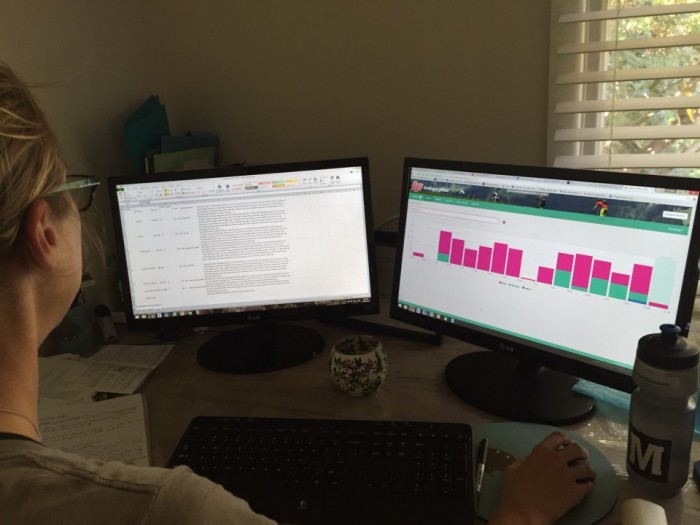Interested in coaching yourself? Over two posts Imogen Smith takes you through your options
In law they have a saying (sometimes attributed to Abraham Lincoln) that the attorney who represents himself in court has a fool for a client… So if you decide to write your own program for your next mountain bike marathon, how can you avoid getting a fool for a coach?
There are a whole lot of reasons why you might want to give it a go. Maybe you have so many responsibilities off the bike that your training availability changes at the drop of a hat, making you too high-maintenance for a coaching plan within your budget. Maybe you’re just starting out and don’t want to go taking things too seriously just yet, or maybe you want to know that whoever’s in charge cares just as much as you do.
The first step is to do an inventory of your knowledge and experience and determine whether you’re ready. Mark Fenner, coach behind Today’s Plan, where my training program lives, wrote a an excellent blog about the mistakes self-coached athletes make a couple of weeks ago. If you’re interested in coaching yourself you should definitely read it.
I’d also suggest that you come into this with at least a basic knowledge of the tools of the trade. If you understand the following acronyms, you’re probably in a good place to start: RPE, FTP, LTHR, ATL, CTL, TSS, FOR, NFOR. There are many more!
Most importantly, you need to get a sense of what your body can cope with. Often this is learned through trial and error and good old-fashioned ‘feel’. Keep a keen eye out for the signs of overtraining (or non-functional overreaching) and make sure you have the discipline to pull back if you need to. This is probably the hardest lesson for any anyone in sport and the self-coached athlete in particular: when you have a coach telling you to take it easy there’s way less guilt than when you have to make the call yourself.
Made it this far? Great! At this point I think you have two options. You can take a look at online resources using software such as Today’s Plan and Training Peaks, or you can develop your own program from scratch. For anyone who hasn’t done a few dozen hours’ reading, I’d recommend the first option. Option two requires a lot of work and I’ll explore it in my next post.
Option 1: E-coach
Training Peaks and Today’s Plan are two of the best-known software options for athletes looking to train with the help of computer-generated feedback. I’ve used both: Training Peaks allow you to purchase programs for a set length of time (e.g. 12 weeks) written by coaches as famous as Hunter Allen and Joe Friel. There are explanatory videos for trickier things like determining your FTP and programs are usually around the $100 mark, although you’d probably also purchase the premium edition of Training Peaks so you could access the analytics as well (about $120 a year).
Programs from Training Peaks come from some of the best names in the business
While I used to use Training Peaks when I was coached in the past, and many athletes are familiar with it, Today’s Plan are an Aussie start-up who made a splash when they launched with live data tracking on some of our top roadies at this year’s Tour Down Under.
I’ve been using Today’s Plan since its Beta testing stage last year, and it keeps developing with more tools and analytics for self-coached athletes (as well as coaches and athletes working together) added almost weekly. Here’s a run-down for those considering it.
The software provides training programs with workouts designed by Mark Fenner, coach to many Aussie MTB and road racing stars. It works quite differently from Training Peaks, building a program dynamically based on your availability, your experience, and the event you choose. Many big Australian marathons (like the Convict 100 pictured below), complete with their specific loads, are already in the system, so you don’t even have to look up the dates and you’ll know your training will target the precise demands of your race. Each workout is then loaded into your calendar and off you go. A yearly analytics subscription will set you back about $100. Training plans are about $40 for an 8-week program and can include analytics with them.
Data such as the load for our popular marathons, including the Convict 100, is built into your Today’s Plan program
Explanatory videos and the capacity to download workouts to your Garmin help make the process a more ‘live’ experience, as does the Today’s Plan app, which can sync with your heart rate monitor and power meter (provided your phone has the right connectivity) as you ride, uploading all your GPS and ride data when you finish (a bit like the Strava app). If you’re strapped for cash, there’s not even any need for a separate bike computer.
Upcoming rides on the Today’s Plan app
Motivation can be tough for any self-coached athlete, especially if, like me, you train on your own a lot. Today’s Plan combines the serious data and analysis with ‘achievements’, so you can see when you’ve hit new highs in all kinds of areas, like power readings, distance, or sustained heart rate. What’s more, if you’ve got a training plan up and running, you’ll be given a target T-score (measure of training load) and duration for every session, and can be rewarded with a green light if you hit within 15% of this, an orange light for a 35% margin, and a red light if you’ve completely stuffed it up.
Next up I’ll share some handy resources for athletes who want to design their training programs from scratch. Read Part Two here

